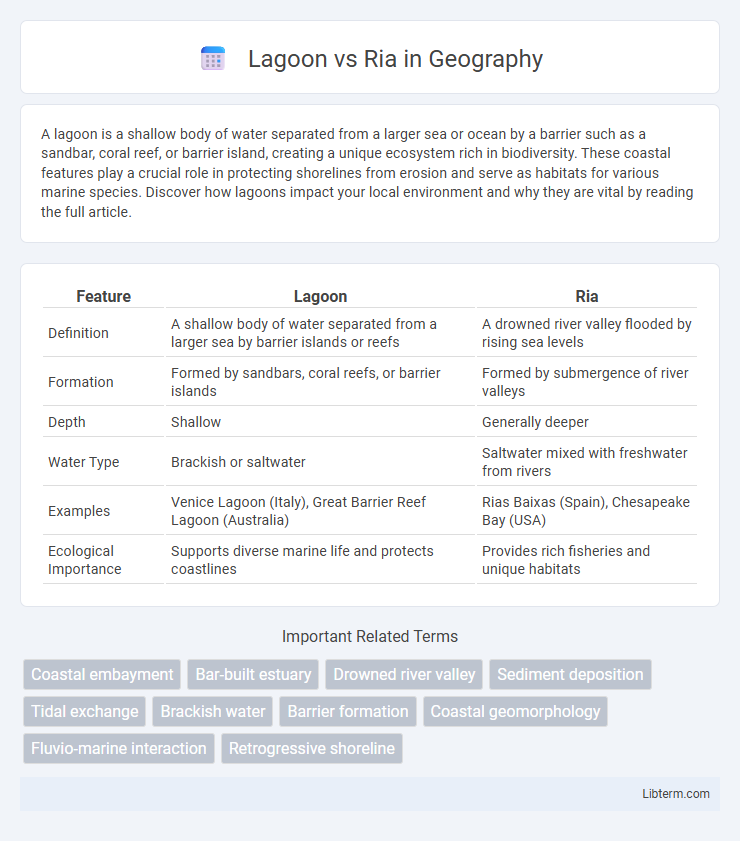A lagoon is a shallow body of water separated from a larger sea or ocean by a barrier such as a sandbar, coral reef, or barrier island, creating a unique ecosystem rich in biodiversity. These coastal features play a crucial role in protecting shorelines from erosion and serve as habitats for various marine species. Discover how lagoons impact your local environment and why they are vital by reading the full article.
Table of Comparison
| Feature | Lagoon | Ria |
|---|---|---|
| Definition | A shallow body of water separated from a larger sea by barrier islands or reefs | A drowned river valley flooded by rising sea levels |
| Formation | Formed by sandbars, coral reefs, or barrier islands | Formed by submergence of river valleys |
| Depth | Shallow | Generally deeper |
| Water Type | Brackish or saltwater | Saltwater mixed with freshwater from rivers |
| Examples | Venice Lagoon (Italy), Great Barrier Reef Lagoon (Australia) | Rias Baixas (Spain), Chesapeake Bay (USA) |
| Ecological Importance | Supports diverse marine life and protects coastlines | Provides rich fisheries and unique habitats |
Introduction to Lagoons and Rias
Lagoons are shallow coastal bodies of water separated from the ocean by barrier islands or reefs, often characterized by brackish water and limited water exchange with the open sea. Rias, on the other hand, are drowned river valleys formed by rising sea levels, creating deep, elongated inlets that extend inland and have a mix of fresh and saltwater. Both features are significant coastal landforms, with lagoons typically serving as important ecological habitats and rias often acting as natural harbors or estuaries.
Defining Lagoons: Features and Formation
Lagoons are shallow coastal water bodies separated from the ocean by barrier islands, reefs, or sandbars, characterized by brackish or saline water and limited oceanic exchange. Their formation results from the accumulation of sediment along coastlines, leading to the enclosure of an area by natural barriers. These features differentiate lagoons from rias, which are drowned river valleys with deeper waters and open connections to the sea.
Understanding Rias: Characteristics and Origins
Rias are coastal inlets formed by the partial submergence of unglaciated river valleys, resulting in a drowned river valley that retains a branched, funnel-like shape. Unlike lagoons, which are shallow water bodies separated from larger seas by sandbars or coral reefs, rias have deep, steep-sided valleys that contribute to strong tidal currents and complex ecosystems. Commonly found along Atlantic coastlines, particularly in regions like Galicia, Spain, rias provide rich habitats for marine life and are often used as natural harbors due to their depth and shelter.
Key Differences Between Lagoons and Rias
Lagoons are shallow coastal water bodies separated from the ocean by barrier islands or reefs, often characterized by brackish water and limited tidal exchange. Rias are drowned river valleys formed by rising sea levels, exhibiting deeper, funnel-shaped estuaries with strong tidal currents. Key differences include their origin--lagoons result from sediment deposition and barrier formation, while rias arise from submergence of river valleys--and their hydrodynamics, with lagoons typically having restricted water flow compared to the well-mixed waters of rias.
Geographical Distribution of Lagoons vs Rias
Lagoons predominantly occur along low-energy coastlines in tropical and subtropical regions, such as the Caribbean Sea and the coasts of Australia, where sandy barriers or coral reefs enclose shallow bodies of water. Rias are common in regions with drowned river valleys, typically found along the Atlantic coasts of Europe, including Galicia in Spain and parts of Ireland, where rising sea levels have submerged river valleys forming deep, narrow inlets. The geographical distribution of lagoons favors warm climates with sediment accumulation, while rias are mostly associated with temperate zones and tectonically influenced coastal landscapes.
Ecological Roles in Coastal Environments
Lagoons and rias both serve as critical ecological habitats in coastal environments, supporting diverse marine and bird species. Lagoons typically have restricted water exchange with the open sea, creating brackish conditions that promote unique ecosystems rich in seagrass beds and nutrient cycling. Rias, formed by submerged river valleys, offer deep estuarine environments that provide crucial nurseries for fish and support complex food webs influenced by both freshwater and tidal inputs.
Human Uses of Lagoons and Rias
Lagoons serve as vital hubs for aquaculture, supporting the cultivation of fish, shellfish, and seaweed due to their calm, nutrient-rich waters. Rias, characterized by deep, submerged river valleys, provide natural harbors that facilitate maritime trade, fishing industries, and recreational boating activities. Both ecosystems support tourism and local economies but differ in their specific human uses based on water depth and salinity gradients.
Environmental Challenges and Conservation
Lagoons face environmental challenges such as nutrient pollution and sedimentation, which disrupt their delicate ecosystems and threaten biodiversity. Rias are vulnerable to coastal erosion and saline intrusion, impacting both marine life and surrounding human communities. Effective conservation efforts for both involve habitat restoration, pollution control, and sustainable land use management to preserve water quality and ecological balance.
Case Studies: Famous Lagoons and Rias Worldwide
The Venice Lagoon in Italy and the Ria de Arousa in Spain exemplify distinct coastal formations with unique ecological and economic impacts. Venice Lagoon, a shallow body of brackish water separated from the Adriatic Sea, supports rich biodiversity and a thriving tourism industry influenced by its historical architecture. In contrast, the Ria de Arousa, a drowned river valley flooded by rising sea levels, is renowned for its productive fisheries and aquaculture, underpinning the local economy and preserving marine habitats.
Summary: Choosing Lagoon or Ria for Coastal Development
Lagoon and ria formations offer distinct advantages for coastal development, with lagoons providing sheltered, shallow environments ideal for aquaculture and tourism infrastructure. Rias, as submerged river valleys, offer deep and navigable waters suited for ports and maritime industries. Evaluating factors such as water depth, sedimentation rates, ecological sensitivity, and development goals is essential when choosing between lagoon or ria sites for sustainable coastal projects.
Lagoon Infographic

 libterm.com
libterm.com